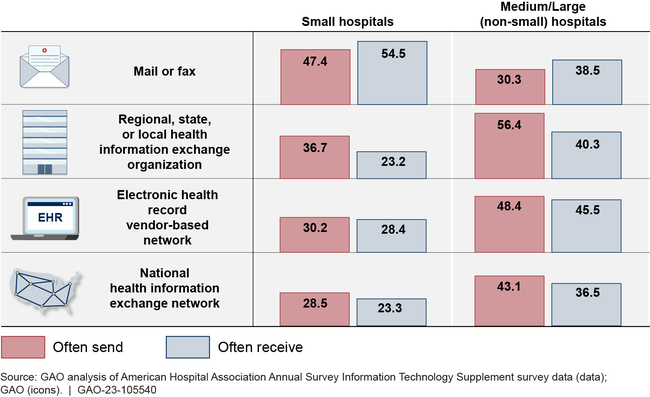Electronic Health Information Exchange: Use Has Increased, but Is Lower for Small and Rural Providers
Fast Facts
"Electronic health information exchange" enables the sharing of medical records electronically among health care providers, and between providers and patients.
The use of electronic exchange among hospitals and physicians has increased in recent years, partly due to federal funds that helped advance its use.
However, we found that the use of electronic exchange among small and rural hospitals was lower than that of other hospitals. This may be because such providers are less likely to have the financial and technical resources to participate in electronic exchange—such as adequate IT staff and sufficient access to broadband internet.

Highlights
What GAO Found
Electronic health information exchange is the ability to exchange medical records and other health information electronically among health care providers and between health care providers and patients. The Health Information Technology for Economic and Clinical Health (HITECH) Act provided federal enhanced Medicaid matching funds to states through 2021 to support certain efforts to advance electronic exchange. Nearly all states used these funds, and most have identified other sources to sustain those efforts.
Survey data show that the use of various electronic exchange methods among hospitals and physicians has increased in recent years. However, GAO found that as of 2021, reported use among small and rural hospitals was lower than that of other hospitals. For example, see figure illustrating use by size of hospital.
Exchange Methods Often Used among Acute Care Hospitals by Size, 2021

Stakeholders GAO interviewed noted that small and rural providers were less likely to have the financial and technological resources to participate in or maintain electronic exchange capabilities.
Federal efforts may address some impediments to electronic health information exchange. Specifically, the Trusted Exchange Framework and Common Agreement being implemented by the Office of the National Coordinator for Health Information Technology (ONC)—which aims to describe a common set of nonbinding principles to help facilitate exchange among health information networks—may mitigate costs providers face by providing a simpler approach to connecting with other providers. However, stakeholders noted that participation in this effort is voluntary and does not address issues like information technology staffing shortages and gaps in broadband access that pose particular challenges to electronic exchange for small and rural providers.
Why GAO Did This Study
Widespread adoption of electronic health information exchange has the potential to improve health care quality and reduce costs. While these goals have been pursued for years, they have proved challenging to realize. Through the HITECH Act, the federal government provided $2.4 billion to states to improve and advance certain aspects of electronic health information exchange.
In light of this federal investment, GAO was asked to review health information exchange. This report describes (1) states' use of the HITECH funding for health information exchange efforts and their plans to replace those funds, (2) the extent to which use of electronic health information exchange has changed since the enactment of the HITECH Act, and (3) federal efforts that aim to address challenges to electronic health information exchange.
GAO reviewed information and interviewed officials from ONC and the Centers for Medicare & Medicaid Services, the agency that administered the HITECH funding. GAO also conducted interviews with state agencies in eight states selected based on geographic variation and whether states accessed the HITECH funding for health information exchange, among other factors. In addition, GAO analyzed hospital and physician survey data, and interviewed a range of stakeholders, including physicians and organizations representing physicians, as well as organizations representing hospitals, payers, health information exchange organizations, and other industry representatives.
For more information, contact Leslie V. Gordon at (202) 512-7114 or gordonlv@gao.gov.
